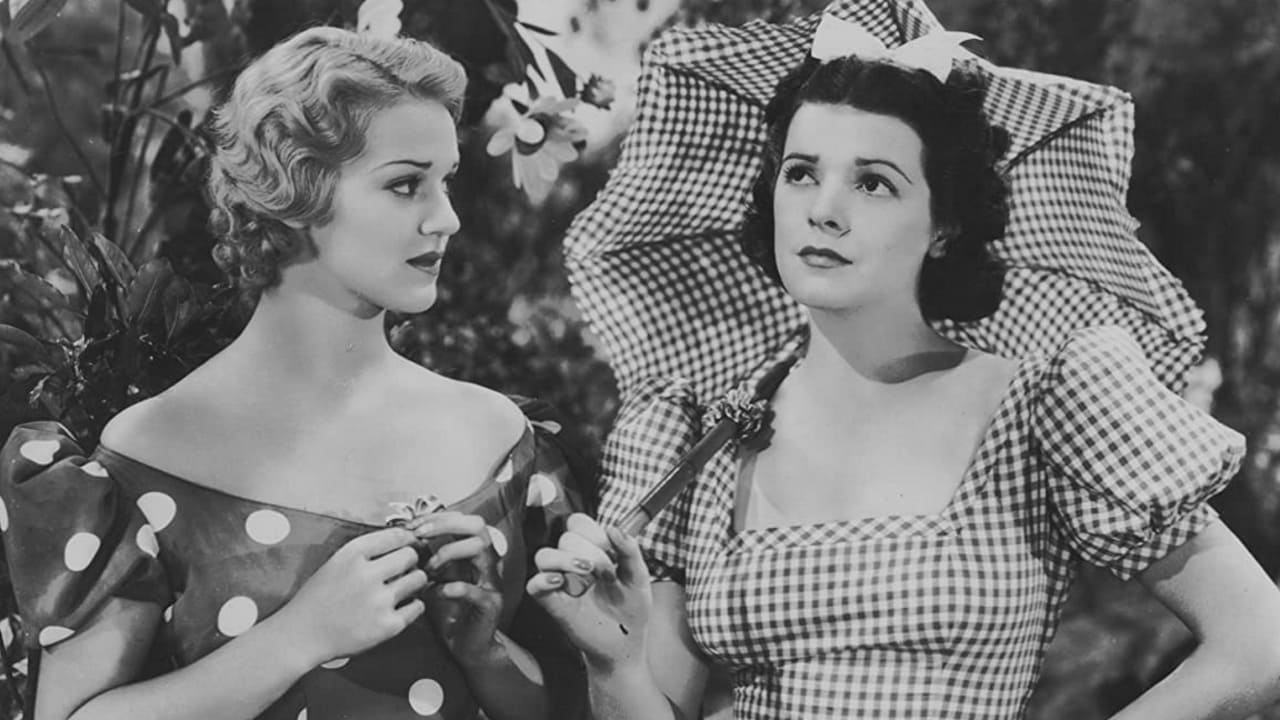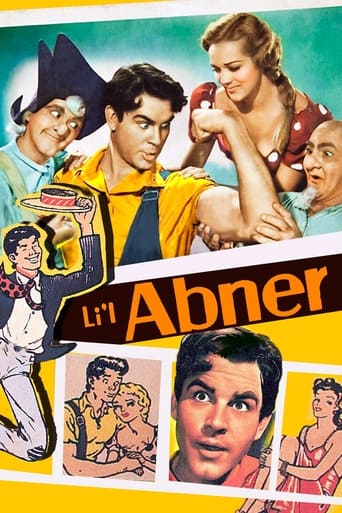

In rural Dogpatch, most eligible young women want to marry hunky Jeff York (as Li'l Abner). Curly blonde Martha O'Driscoll (as Daisy Mae) tries to arouse Mr. York with cleavage and a twisted ankle, but York doesn't want to get hitched. When a phony doctor gives him 24 hours to live, he reconsiders. Also turned on by dark-haired Kay Sutton (as Wendy Wilecat), York eventually finds himself engaged to both women. Based on Al Capp comic strip, this version of "Li'l Abner" is flat and uninspired. It does have an interesting cast of veterans, though, including Buster Keaton (as Lonesome Polecat) doing his stone-faced Indian schtick.*** Li'l Abner (11/1/40) Albert S. Rogell ~ Jeff York, Martha O'Driscoll, Buster Keaton, Maude Eburne
... View MoreBy the time LI'L ABNER went into production, Al Capp's comic strip of the same name had been running for about six years and was well on its way of becoming a household name. Even so, the idea of putting Dogpatch to life on the silver screen was not as inevitable as one might think. While other popular comic strips of the day had made it to Hollywood already (Blondie, Bringing Up Father and The Katzenjammer Kids being some examples), the task of transforming real-life actors into representatives of the slightly grotesque Dogpatch-universe obviously was of another level. However, from a visual point of view the result is reasonably successful; it truly looks as if we've been granted a visit into the authentic li'l town. On other points, however, the film is hit-and-miss; mostly the latter.Capp himself is given credit as story writer, although his actual contributions to the script may have been sparse. However, on the surface the premise resembles a typical Li'l Abner daily-strip adventure of the time. Abner thinks he's poisoned after eating some old, no-good mustard, and is determined to do a last good deed by "making love" to Daisy Mae, who adores him as much as ever ("making love" in Dogpatch is, of course, another term for kissing). As it turns out, Abner awakens "not daid" after all, very much to his dismay, as he's promised to marry no less than two girls the following noon (one being Daisy). It is decided that Abner is henceforth "resarved" for Daisy and the other girl in the upcoming Sadie Hawkins Day Race...may the best girl win.It's apparent that the film's director, Albert Rogell, understood the importance of transforming Capp's character designs onto the silver screen through the actors, in order to make this project reasonably credible; it also seems likely that actors Jeff York (Abner, billed as Granville Owen), Martha O'Driscoll (Daisy Mae), Mona Ray (Pansy Yokum), Johnnie Morris (Lucifer Yokum) and the rest of the principal performers did their share of research on beforehand. The make-up alone does not make the resemblance; facial expressions, timing and over-the-top voices are all of a very "Dogpatchesque" kind, in lack of a better word. A special mention also goes to former giant of silent comedy Buster Keaton as Lonesome Polecat, a performance which seems to be directly responsible for this film being so easily accessible on the video market today.However, despite the visually successful incarnations, LI'L ABNER does essentially remain a curiosity piece, certainly of most amusement to people well acquainted with the many references from Capp's strip. And it's not a guarantee that even viewers familiar with the strip will find all that much merriment here. The first time I watched it, now several years ago, I had only read a little of the strip, making this film a rather confusing (not amoozin') experience. However, since then I've become a Li'l Abner die-hard, so when I gave Columbia's adaptation another try recently, it turned out more comprehensible, and maybe slightly more enjoyable. People giving the film a try just for the sake of Keaton's performance, like I did at first, will hardly see more in it than a bizarre B-film comedy without much sense. It doesn't help matters that the direction appears like a rush-job on some instances, and furthermore that the prints currently in circulation are in less than neat condition; the last shot in the film is confusing, and in fact I suspect that a scene is missing. The script is equally indifferent; none of Capp's satirical talent has been incorporated, and the humor generally relies on rather obvious gags and punch-lines, though on some occasions it may be fun to recognize the odd traits and phrases of the main characters.Capp is said to have been quite disappointed with the film, and understandably so. Apart from a few equally forgettable animated shorts, nearly twenty years would pass before Li'l Abner was brought onto the silver screen again (this time somewhat more satisfyingly). As for this 1940-version, as a curiosity-piece it's worth checking out to die-hard fans of the strip, but newcomers should spend their time hunting for re-printings of the strip instead.
... View MoreI came across the budget DVD of this one some time back though I never got around to renting it, not so much because of, say, Leonard Maltin’s lowly opinion but rather the unavailability of the later and better-known musical version from 1959. Consequently, I’d previously been interested in it more as a Buster Keaton film (in fact, many a Silent comedian make an appearance here) than as an adaptation of the Al Capp comic strip – but, having now found the latter as well, I decided to make it a double-bill! In retrospect, Keaton’s role is minor (playing the Indian Lonesome Polecat who has a long-haired and eyeless giant for a sidekick) despite the ballyhoo regarding his presence on the DVD front cover.Still, despite its intrinsic cornball nature, the film proved less oppressive than I had anticipated: being a low-budget production and a brief 73 minutes in length, the plot (as seen in the musical version) has been considerably streamlined – focusing solely on the Sadie Hawkins’ Day race (where the unwedded females of Dogpatch pursue the community’s eligible bachelors) and the character of the villainous Earthquake McGoon. Even so, the piece’s essence is already there – including the unexpected earthiness of the girls; it goes without saying, however, that the later film is the more satisfactory rendition of LI’L ABNER.
... View MoreIn comparison to the 1959 musical, this non-musical 1940 version seemed closer to the comic strip in ways the musical missed.There was more of a feeling of shut-off from society in the 1940 film. Granville Owen was far better than Peter Palmer in '59.Mammy bathing Pappy Yokum is a scene to behold all on its own. Granted the performers probably didn't need the makeup tho, as Granny Scragg did indeed make for a memorable character with no facial makeup.Always nice to see Buster Keaton. The very first person we would see was Daisy Mae (in bed, no less), so clearly there was supposed to be some launching of a screen beauty here.This movie would make better use of the dregs of Dogpatch society, such as Fantastic Brown's wife saying it is time for his bath. We also see Abijah Gooch (always liked that name) and Hannibal Hoops.By far one of the best lines must be when Hairless Joe proclaims about the ten dollar reward for Earthquake McGoon, "ain't that much money in all tarnation!" Peter Palmer may have been able to sing better, but Granville Owen got the character down much better. The actor who portrayed Earthquake McGoon here would be the actual wrestler who inspired the character in the comic strip. Using the term 'actor' loosely, as he really didn't offer much of a performance. This movie would have none of Capp's 'satirical humor' in it, but if the musical contained any of the strip's statements, it really didnt shine through there either.
... View More